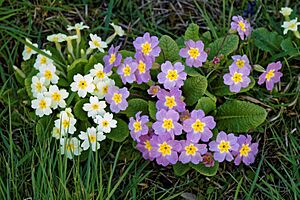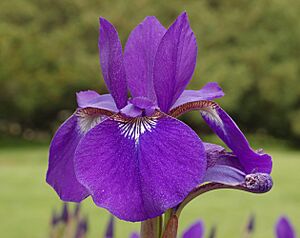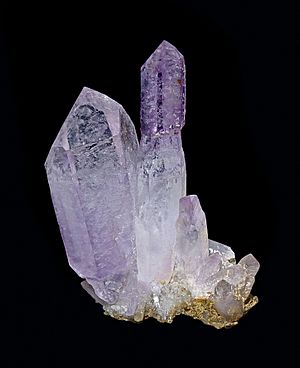February facts for kids
February is the second month of the year in both the Julian and Gregorian calendars. It usually has 28 days. But, in a leap year, February gets an extra day, making it 29 days long. This extra day is called a leap day. February is the only month with fewer than 30 days.
In the Northern Hemisphere, February is the last month of winter. In the Southern Hemisphere, it's the last month of summer. This means February in the Southern Hemisphere is like August in the Northern Hemisphere.
Contents
How to Say "February"
The word "February" can be tricky to say! Most people say it like "FEB-yoo-air-ee" or "FEB-roo-air-ee". Sometimes, people even drop the first "r" sound, making it sound like "Feb-yoo-air-ee". This often happens because it's similar to "January" and because it's hard to say two "r" sounds so close together.
History of February
The name "February" comes from the Latin word februum, which means "purification". This is because of a special cleaning ritual called Februa that happened on February 15th in the old Roman calendar.
At first, the Romans didn't even have January and February in their calendar. They thought winter was just a time with no months! Around 713 BC, a Roman king named Numa Pompilius added these two months. For a while, February was the last month of the year. Later, it became the second month, just like it is today.
Sometimes, in the old Roman calendar, February was shortened to 23 or 24 days. An extra month, called Intercalaris, was sometimes added after February. This helped keep the calendar lined up with the seasons.
When the Julian calendar was created, the extra month was removed. Instead, a leap year with 29 days in February was added every four years. The Gregorian calendar later made small changes to how leap years are figured out, but February still kept its 29th day in leap years.
Many cultures have had different names for February. For example, in Old English, it was called "Solmonath" (mud month) or "Kale-monath" (cabbage month). In Finnish, it's helmikuu, which means "month of the pearl". This is because melting snow on branches can freeze into ice droplets that look like pearls. In Polish and Ukrainian, the name means "month of ice" or "hard frost".
Special Patterns
February is unique because it's the only month that can pass without a single full moon. This happens when the full moon falls very early in March and very late in January. The last time this happened was in 2018, and it will happen again in 2037. The same can happen with a new moon.
February is also the only month that can have exactly four full weeks (28 days). This happens in certain common years. For example, if February 1st is a Monday, then February 28th will be a Sunday, making exactly four weeks.
Astronomy in February
Several meteor showers can be seen in February. These include the Alpha Centaurids and the Delta Cancrids. Meteor showers are when you can see many "shooting stars" as Earth passes through dust left by comets.
Symbols of February


The zodiac signs for February are Aquarius (until February 18) and Pisces (from February 19 onward).
The birth flowers for February are the violet, the common primrose, and the Iris. The birthstone for February is the amethyst. This beautiful purple gem is said to stand for honesty, wisdom, and sincerity.
Observances in February
Many special days and observances happen in February.
Month-long Observances
- American Heart Month (United States)
- Black History Month (United States, Canada)
- LGBT History Month (United Kingdom, Ireland)
Movable Observances
These dates change each year:
- Safer Internet Day: First day of the second week.
- Ice Cream for Breakfast Day: First Saturday.
- Mother's Day (Kosovo): First Sunday.
- World Interfaith Harmony Week: First week of February.
- Constitution Day (Mexico): First Monday.
- National Wear Red Day (United States): First Friday.
- Super Bowl Sunday (United States): Second Sunday.
- World Marriage Day: Second Sunday.
- Family Day (Canada) (in some Canadian provinces): Third Monday.
- President's Day/Washington's Birthday (United States): Third Monday.
- Rare Disease Day: Last day of February.
Fixed Observances
- February 1
- Abolition of Slavery Day (Mauritius)
- Federal Territory Day (Kuala Lumpur, Labuan and Putrajaya, Malaysia)
- Imbolc (Ireland, Scotland, Isle of Man)
- February 2
- Feast of the Presentation of Jesus at the Temple (or Candlemas)
- Groundhog Day (United States and Canada)
- World Wetlands Day
- February 3
- Communist Party of Vietnam Foundation Anniversary (Vietnam)
- Setsubun (Japan)
- February 4
- Independence Day (Sri Lanka)
- World Cancer Day
- February 6
- Waitangi Day (New Zealand)
- February 8
- Prešeren Day (Slovenia)
- February 9
- National Pizza Day (United States)
- February 11
- 112 day (European Union)
- National Foundation Day (Japan)
- World Day of the Sick (Roman Catholic Church)
- February 12
- Darwin Day (International)
- Lincoln's Birthday (United States)
- Union Day (Myanmar)
- February 13
- World Radio Day
- February 14
- Valentine's Day (International)
- February 15
- National Flag of Canada Day (Canada)
- Statehood Day (Serbia)
- February 16
- Restoration of Lithuania's Statehood Day (Lithuania)
- February 17
- Independence Day (Kosovo)
- Random Acts of Kindness Day (United States)
- February 18
- Independence Day (Gambia)
- February 19
- Flag Day (Turkmenistan)
- February 20
- World Day of Social Justice
- February 21
- International Mother Language Day
- Language Movement Day (Bangladesh)
- February 22
- Independence Day (Saint Lucia)
- Founder's Day (Saudi Arabia)
- Founder's Day or "B.-P. day" (World Organization of the Scout Movement)
- World Thinking Day (World Association of Girl Guides and Girl Scouts)
- February 23
- February 24
- Independence Day (Estonia)
- February 25
- National Day (Kuwait)
- People Power Day (Philippines)
- February 26
- Liberation Day (Kuwait)
- February 27
- International Polar Bear Day
- Independence Day (Dominican Republic)
- February 28
- February 29 (in leap years)
- Bachelor's Day (Ireland, United Kingdom)
See also
 In Spanish: Febrero para niños
In Spanish: Febrero para niños




